Symbols of all 24 Violin Bowing Techniques in Sheet Music | Violin Lounge TV #371
How is the notation of violin bow techniques in sheet music?
Here’s how to know exactly which technique to use when:
After making my video explaining and demonstrating 24 violin bowing techniques, I got several requests to show how they look in sheet music, so you know what technique to use when. That’s not so easy ;).
The difficulty is that several bow techniques have the same notation and different notations are used for the same bow technique
(composers and arrangers: this info will save you quite some fights with the string section)
What to do is often not clear from the sheet music and depends on a combination of:
- Mood that is expressed
- Style or era of the piece
- Speed
- Rhythm
- Dynamics
- Transitions between notes and strings
- Tradition of performance
- Your personal taste and interpretation! (and your violin, bow and unique way of playing)
In music notation we have a limited of ways to indicate what bow stroke to use
Of course there are the signs of up bow and down bow indicating the bow direction. Watch this video to learn all about that.
Besides the up and down bows we haven’t got much: dots or accents above and below the notes, slurs, comma’s and combinations of those… that’s pretty it!
With that we have to indicate all the hundreds of nuances between over 24 bowing techniques on the violin…
In the above video I give you some guidelines to figure out what and how to play the stuff you find in your sheet music. Of course there are tons of exceptions. There are even different markings in different prints of the same piece.
Detaché notation
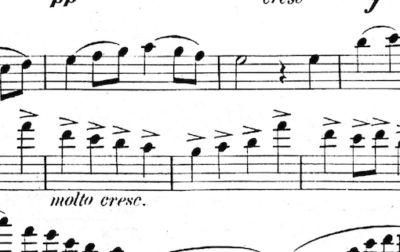 As detaché would be default bowing, most of the times it’s not indicated in sheet music.
As detaché would be default bowing, most of the times it’s not indicated in sheet music.
However, if there are accents it’s marked just as martelé, like in this snippet from Franck’s violin sonata.
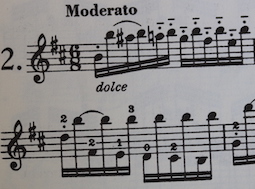 If the detaché should be clearly articulated, you sometimes see lines, dots or a combination of them, like in this snippet from Paganini’s 2nd caprice.
If the detaché should be clearly articulated, you sometimes see lines, dots or a combination of them, like in this snippet from Paganini’s 2nd caprice.
There are twelve (yes, 12!) types of detaché. This article teaches you all about them and how they look in sheet music.
Legato
 Legato is indicated by slurs above the notes without other markings like dots or lines.
Legato is indicated by slurs above the notes without other markings like dots or lines.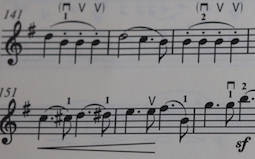
Portato
Portato is indicated in sheet music with slurs and lines or dots above or below the notes. You can distinguish it from a flying spiccato or staccato by the fact that it’s usually at a lower speed.
Double stops, triple stops and chords
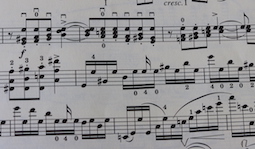 You can recognize a double stop by the fact that there are two notes above each other to be played at the same time. For the triple stops there are three notes and for chords three or four notes.
You can recognize a double stop by the fact that there are two notes above each other to be played at the same time. For the triple stops there are three notes and for chords three or four notes.
Whether you play a triple stop (three notes at the same time) or a broken chord depends on the speed, style period and performance tradition.
Martelé
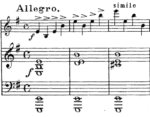 Just as an accented detaché, martelé notes are indicated with accent marks. Sometimes dots are used or a combination of dots and accents. Usually dots mean spiccato, but in a lower tempo they mean martelé or detaché collé depending on the style and idea of the piece.
Just as an accented detaché, martelé notes are indicated with accent marks. Sometimes dots are used or a combination of dots and accents. Usually dots mean spiccato, but in a lower tempo they mean martelé or detaché collé depending on the style and idea of the piece.
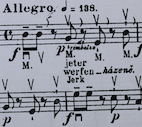 Collé or jeter
Collé or jeter
When the bow needs to be lifted between the notes and slap or land back, it’s indicated by a comma between the notes. How marked and accented the notes should be depends on the musical context. On the right you see an example from Sevcik’s 40 variations.
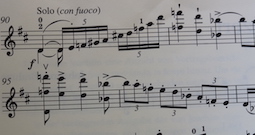 Sometimes the comma is above the notes, like here in the 12th and 13th notes in the opening of the Brahms concerto… and yes, performers can differ about how to call the technique used there.
Sometimes the comma is above the notes, like here in the 12th and 13th notes in the opening of the Brahms concerto… and yes, performers can differ about how to call the technique used there.
Other times a combination of accents and dots is used, like in Kreutzer etude nr 6.
Is this interesting? Share this on Twitter:
Improve your violin bowing technique
Enjoy my FREE mini Masterclass 5 Bowing Secrets to Create a Professional Sound on the Violin

Hi! I'm Zlata
Classical violinist helping you overcome technical struggles and play with feeling by improving your bow technique.
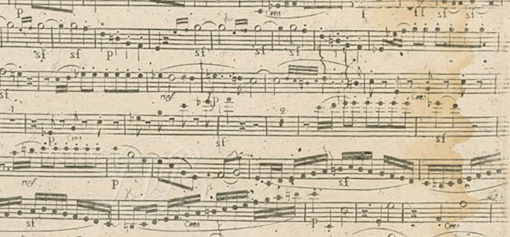 Spiccato
Spiccato
Spiccato is indicated by dots above or below the notes. Sometimes dots mean martelé, but if it does that’s usually written down. Here we see spiccato in Beethoven’s Frühling sonata.
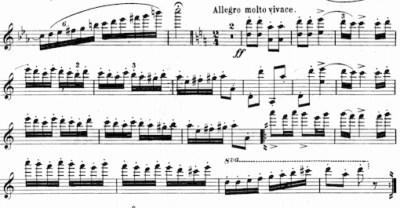 Sautillé
Sautillé
As one of the most important difference between spiccato and sautillé is the speed, sautillé looks the same as spiccato with the dots. Most of the times spiccato is on eighth notes and sautillé on sixteenths notes.
Often however the dots are not there and from the style of the piece one should know it should be played sautillé.
Solid or slurred staccato, flying staccato and flying spiccato
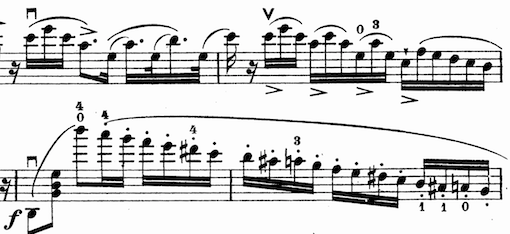 These techniques are all indicated by dots above the notes and a slur. The difference between these three is known from the style of the piece and the performance tradition.
These techniques are all indicated by dots above the notes and a slur. The difference between these three is known from the style of the piece and the performance tradition.
Watch this video to learn the difference between these violin bowing techniques.
Ricochet
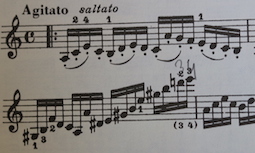 Usually ricochet is also indicated by dots and slurs, but it’s usually in a higher tempo like sixteenth notes and just two to four notes instead of a whole run. Like in this snippet from Paganini’s 5th caprice.
Usually ricochet is also indicated by dots and slurs, but it’s usually in a higher tempo like sixteenth notes and just two to four notes instead of a whole run. Like in this snippet from Paganini’s 5th caprice.
Jumping arpeggio
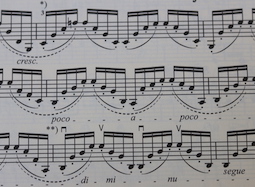 You’ll recognize this by arpeggios over four strings, dots above the notes and a slur for every four notes.
You’ll recognize this by arpeggios over four strings, dots above the notes and a slur for every four notes.
Tremolo
 You can recognize it by the three lines through the stem of the note (or above the note if there is no stem).
You can recognize it by the three lines through the stem of the note (or above the note if there is no stem).
Remember: there are TONS of exceptions!
Often there are no markings of bowing technique and you need to find out what to do based on the musical context.
I’ve tried to give you some guidelines to get you going in most cases, but keep using your own heart and ears to get yourself to your unique interpretation.
Let me know in the comments what was most helpful to you!
Like this? You’ll LOVE my ultimate violin bowing nerd project
Check out my video on 102 different violin bowing techniques, terms and symbols right here!
6 Comments
Trackbacks/Pingbacks
- 24 Different VIOLIN BOWING Techniques | Violin Lounge TV #353 - Violin Lounge - […] Watch this video on how your recognize these bowing techniques and when to do what. […]
- Staccato vs Martelé Violin Bow Techniques | Violin Lounge TV #414 - Violin Lounge - […] Watch this video for notation of 24 different bow techniques in sheet music. […]


Thank you so much for this video and the previous one on 24 bowing techniques! I wish I had seen this 60 years ago when I first started playing violin! I’ve played with various orchestras throughout my life and knowing the correct technique reduces a lot of personal stress and significantly ups one’s creds (smile).
Yeah, but 60 years ago I just was an egg in my mom’s ovary, so the video wouldn’t have been that good ;). I do understand what you mean, however you are not alone: so many people are confused in orchestra playing.
I am thoroughly confused and overwhelmed. I just looked at my learning material and see very few of the things you are talking about. I am still a beginner and it may not be time for m to learn all of these bowing strokes. Time and lessons will surely tell. Never the less I really enjoy your videos. Thank you for making them.
Don’t worry, Robert, just take one thing at a time. These things will come. As a beginner, just focus on getting a decent sound in detaché and only watch these videos for fun :).
Dear All,
Thank you for sharing your information about symbols and letters in sheet notes related to the bow.
Could you please specify the below symbols for bow for cello?
1- B.C.
2- F.C.
3- C.C.
4-HII
Hope there are cello players here who can answer this!